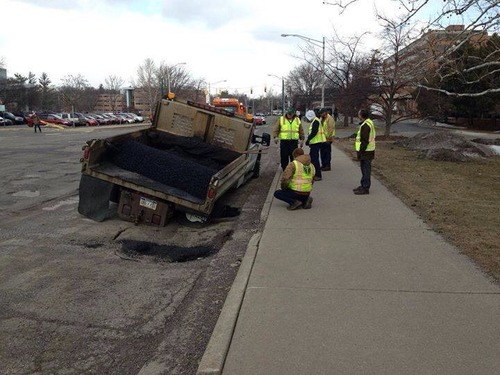Chris Chegash: Michigan Should Fix Its Potholes
This is a guest post from my student Chris Chegash. He also had an earlier guest post here: “College Athletes Deserve a Better Deal.” I agree 100 percent with Chris’s policy recommendation that Michigan should fix its potholes. Indeed, Noah Smith and I make a similar recommendation at the national level in “One of the Biggest Threats to America’s Future Has the Easiest Fix.” But Chris makes the issue much more vivid.
One of the sure ways to know that something is important is when politicians actually agree on something. With the current state of American politics, both conservatives and liberals rarely agree on anything. Yet, when it comes to the current state of the infrastructure in Michigan, everyone seems to agree: The roads in Michigan are awful.
I grew up thinking that the thump-thump you hear when driving down the highway was normal, but as I’ve grown older, I’ve realized this isn’t true. Sad as it is to say, I don’t mind when I cross the Ohio border and finally get some peace and quiet while driving. The data about Michigan’s roads backs this up. The American Society of Civil Engineers gave Michigan’s infrastructure a D in 2009, 2011 and 2013 (they gave the U.S. a D+ nationally). According to the ASCE, about 30% of the bridges in Michigan are either “structurally deficient” or “functionally obsolete” and 38% of Michigan’s roads are in either poor or medicare condition. More importantly, they believe that the poor conditions of the roads in Michigan costs the average motorist an additional $357 dollars per year in car repairs and traffic problems. Some people fear that poor road conditions could drive both new business investment and tourism away.
The fact is that all roads face some deterioration over time, and will need to be replaced eventually, but Michigan has two key factors that enlarge this problem. The most obvious factor is the weather. Driving around in the past few weeks has been an absolute nightmare in Michigan; potholes are everywhere as a result of an extremely cold and snowy winter. When water seeps into cracks and later freezes, it expands and enlarges the cracks. This is why the potholes have been especially prevalent and dangerous after this prolific winter season. The second major factor that causes increased wear and tear on Michigan’s roads is a poor public transportation system. The most often cited cause for a subpar public transit system in Michigan is the local interests of the major car manufacturers. Since better public transit means less cars, the major car companies like Ford, GM, and Chrysler all have an interest in opposing public transit. Over time, this has lead to woeful public options in Michigan (Ann Arbor is probably far better than most areas).
The real question lies in where the money to fund road improvements will come from. In 2013 Michigan governor Rick Snyder proposed a $1.2 billion increase in road funding, funded through either an increase in the gas tax and other fees, or an increase in the state income tax. The Michigan Infrastructure and Transportation Association thinks the true cost of fixing Michigan’s roads is around $2 billion per year in additional funding, far more than the number governor Snyder has proposed (there are some great graphics in the full report here). However, the proposals in the Michigan legislator fall well short of that funding level, there are new proposals in state Congress to increase road funding by $450 million per year. The additional funding would come from diverting 1% of our of Michigan’s current 6% sales tax to roadwork andthrough eliminating the flat gas tax and instead taxing it at 6%. Thus, if prices rise higher than $3.55 per gallon, the tax will be more expensive than the previous 18 cent per gallon tax. Proponents of this tax are eager to point out that a gas tax makes people who drive more pay more in taxes, which seems smart.
This proposal has two major issues:
- Coming up with the $450 million per year: Lawmakers putting together this proposal had to find $400 million dollars to take from other parts of the budget, because actual revenues are expected to increase by only about $50 million. This means that if the proposal is adopted, some other project is losing $400 million.
- $450 million per year is not enough: The amount of new funding is still well short of the additional funding governor Snyder proposed and is well short of what experts think is necessary to solve this problem.
Another option that people frequently talk about is the use of toll roads to generate revenue. Unfortunately, most of Michigan’s highways aren’t eligible to be used as toll roads. Since the federal government funded a significant portion of the costs of state highways, those roads cannot be used as toll roads without repaying the government for their original investment. Although there are some ways around these rules, trying to convert Michigan’s road into toll roads wouldn’t be financially viable.
The problem of poor roads isn’t going away any time soon, and so lawmakers must act to better fund the roads in Michigan; waiting will only make the roads worse. Although difficult, I believe that residents must accept a slight tax increase in order to improve Michigan’s dilapidated road network.
